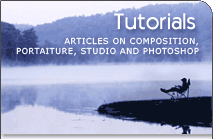This article belongs completely to Ed Shapiro, a professional photographer, who contributed a lot to the art. It is based on the content of a topic of forum. I have to thank Ed for covering this topic. I could not find any place where Ed gathered and published his knowledge, so I decided to extend the audience of the forum where he posted this topic. So here it goes...
Put away the charts
All the lighting illustrations, graphs, charts and diagrams are handy to a point. For that matter formulas that work all or most of the time are good because, at some point in time, as a professional photographer, there are things that you need to be able to do, on demand where there is no time for too many calculations- creativity on demand; set it up shoot it and get on to your next assignment!
Yes, you gotta make a living to get things started and you have to know what you are doing. You will however, run into situations where the calculations, tips and all the other literature doesn't work and that is why an ongoing study of the fine points of lighting is a good idea, even for seasoned professionals. Here is an example: If you try to establish ratios by the numbers, this will not always work unless you are working in a fixed studio camera room where the all over lighting effects are always predictable. There is a phenomena called “unseen secondary light”. This theory is based on the tremendous amount of “bounce” light that is present especially when you are using electronic flash. Even under studio conditions, this can flatten out a ratio that has been calculated only by the numbers. The ratio will be influenced by the shape, size and color of the camera room as well as the clothing the subject(s) are dressed in. As soon as you go on location, every thing can change.
Another example of the sort of variations you might expect has to do with the angle of incidence at which lights are placed in relation to the camera/subject axis. Say you have the ratio of the main and fill lights down pat and you decide to add a kicker or accent light to the mix. One would usually think to meter the kicker light from the subject position and see that it matches the output of the main light. The results of that would probably be that the highlights from that kicker light would be washed out and much brighter, in appearance, than the main light. In this case the kicker would not be an interesting addition to the main light but would become a distraction leading the viewer's eye from the important part of the face brought out by correct main light usage. That happens because the kicker, being at a grater angle of incidence (perhaps as much as 130 degrees from the camera/subject axes) will show as a brighter source than the main (which is only 30 to 45 degrees from the camera subject axis) even if it (the kicker) is set at the same power setting and/or distance as the main light. The kicker would have to be reduced in power electronically or fitted with a diffuser to reduce its apparent power by as much as a full f/stop. The formula is the angle of incidence is equal to the angle of reflection.
~ Top ~There are dozens if not hundreds of variations that affect all aspects of photographic lighting.
My big tip for today is to study the physics and aesthetics of light and lighting and use this data to create and troubleshoot real lighting situations. Learn to see light whether it is coming from the sun, a flash unit, a window, a candle or the shaded area under a porch or an overhanging tree. Look at the color of the light and the mood it sets. Look for it all the time - watch the light from a computer monitor and see how it falls on the operators face. Look at the way a table or desk lamp sheds light on the surface of the table or desk and how it lights a person sitting at that table or desk. If you are called upon to shoot such a scene you will know how it supposed to look.
Meanwhile - Here are some tips of theories to study in learning the dynamics of light:
- Unseen secondary light.
- Angle of incidence.
- Feathering your lights.
- Proper exposure.
- Quality of light vs. quantity of light.
- The nature of various light sources.
- Lighting forms.
Remember, an exposure meter is only a tool to get you in the ballpark- it is up to you, as the photographer to interpret the readings that you obtain and fine tune things to create the images in your mind's eye. The meter, even of the most sophisticate type, can not factor in or account for nuances that only your eyes can see and your mind can tell. There are no "tricks", only applied skills. ![End of the article [end of the text]](http://www.romanzolin.com/img/misc/text_end_ed.png)





